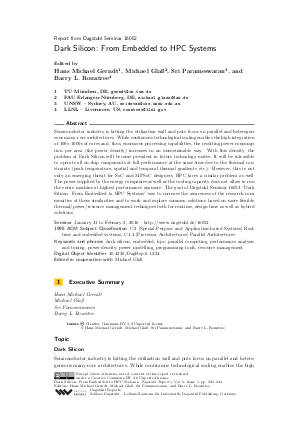Dark Silicon: From Embedded to HPC Systems (Dagstuhl Seminar 16052)
Authors Hans Michael Gerndt, Michael Glaß, Sri Parameswaran, Barry L. Rountree and all authors of the abstracts in this report
-
Part of:
Issue:
Dagstuhl Reports, Volume 6, Issue 1
Part of: Volume: Dagstuhl Reports, Volume 6
Part of: Journal: Dagstuhl Reports (DagRep) - License:
 Creative Commons Attribution 3.0 Unported license
Creative Commons Attribution 3.0 Unported license
- Publication Date: 2016-07-12
File

PDF
DagRep.6.1.224.pdf
- Filesize: 0.97 MB
- 21 pages
Document Identifiers
Subject Classification
Keywords
- dark silicon
- embedded
- hpc
- parallel computing
- performance analysis and tuning
- power density
- power modelling
- programming tools
- resource manageme
Metrics
- Access Statistics
-
Total Accesses (updated on a weekly basis)
0Document
0Metadata
Abstract
Semiconductor industry is hitting the utilization wall and puts focus on parallel and heterogeneous many-core architectures. While continuous technological scaling enables the high integration of 100s-1000s of cores and, thus, enormous processing capabilities, the resulting power consumption per area (the power density) increases in an unsustainable way. With this density, the problem of Dark Silicon will become prevalent in future technology nodes: It will be infeasible to operate all on-chip components at full performance at the same time due to the thermal constraints (peak temperature, spatial and temporal thermal gradients etc.). However, this is not only an emerging threat for SoC and MPSoC designers, HPC faces a similar problem as well: The power supplied by the energy companies as well as the cooling capacity does not allow to run the entire machine at highest performance anymore. The goal of Dagstuhl Seminar 16052 "Dark Silicon: From Embedded to HPC Systems" was to increase the awareness of the research communities of those similarities and to work and explore common solutions based on more flexible thermal/power/resource management techniques both for runtime, design time as well as hybrid solutions.
Cite As Get BibTex
Hans Michael Gerndt, Michael Glaß, Sri Parameswaran, and Barry L. Rountree. Dark Silicon: From Embedded to HPC Systems (Dagstuhl Seminar 16052). In Dagstuhl Reports, Volume 6, Issue 1, pp. 224-244, Schloss Dagstuhl – Leibniz-Zentrum für Informatik (2016)
https://doi.org/10.4230/DagRep.6.1.224
BibTex
@Article{gerndt_et_al:DagRep.6.1.224,
author = {Gerndt, Hans Michael and Gla{\ss}, Michael and Parameswaran, Sri and Rountree, Barry L.},
title = {{Dark Silicon: From Embedded to HPC Systems (Dagstuhl Seminar 16052)}},
pages = {224--244},
journal = {Dagstuhl Reports},
ISSN = {2192-5283},
year = {2016},
volume = {6},
number = {1},
editor = {Gerndt, Hans Michael and Gla{\ss}, Michael and Parameswaran, Sri and Rountree, Barry L.},
publisher = {Schloss Dagstuhl -- Leibniz-Zentrum f{\"u}r Informatik},
address = {Dagstuhl, Germany},
URL = {https://drops.dagstuhl.de/entities/document/10.4230/DagRep.6.1.224},
URN = {urn:nbn:de:0030-drops-58198},
doi = {10.4230/DagRep.6.1.224},
annote = {Keywords: dark silicon, embedded, hpc, parallel computing, performance analysis and tuning, power density, power modelling, programming tools, resource manageme}
}
